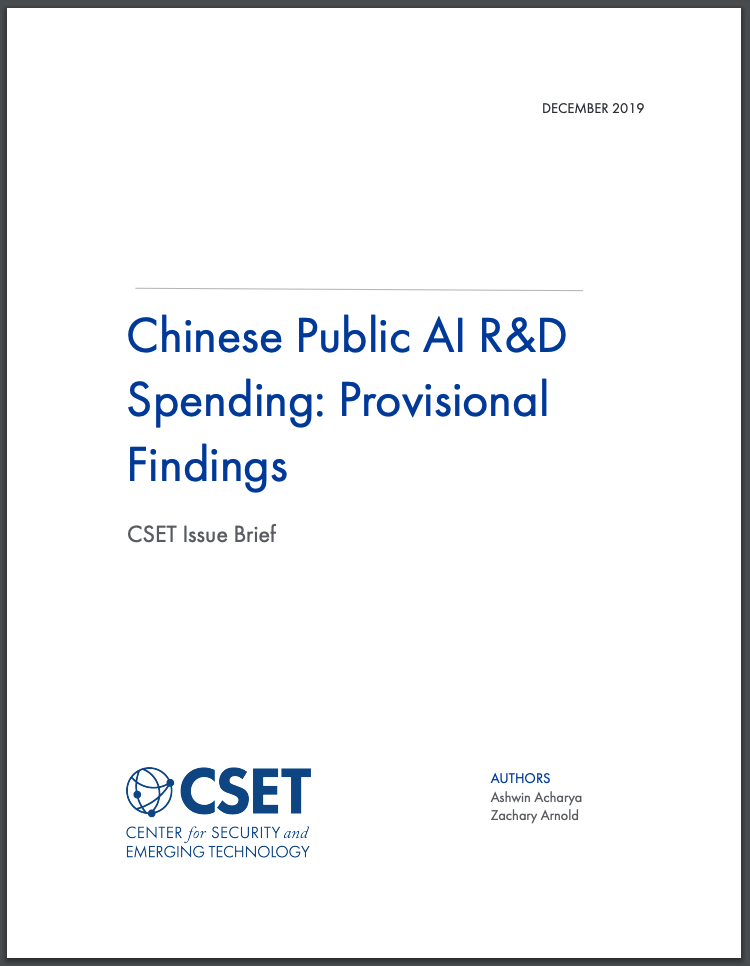China aims to become “the world’s primary AI innovation center” by 2030.1 Toward that end, the Chinese government is spending heavily on AI research and development (R&D). This memo provides a provisional, open-source estimate of China’s spending.
We assess with low to moderate confidence that China’s public investment in AI R&D was on the order of a few billion dollars in 2018. With higher confidence, we assess that China’s government is not investing tens of billions of dollars annually in AI R&D, as some have suggested.2
Significant data gaps prevent us from producing a more precise estimate of China’s spending at this time, especially with respect to defense R&D. However, our rough estimate and the underlying analysis do allow us to rule out higher estimates with moderate to high confidence.
Additional findings include:
- China’s government probably isn’t dramatically outspending the U.S. government on AI R&D. While we did not analyze U.S. AI R&D spending in any depth for this paper, our results indicate that China’s spending in 2018 was on the same order of magnitude as U.S. planned spending for FY 2020, as documented elsewhere.3
- Chinese public AI R&D spending probably tilts heavily toward applied research and experimental development, not basic research. This is consistent with China’s overall public R&D spending.4
- China’s government may be investing a few billion dollars a year (at most) in private-sector AI activity through guidance funds—essentially, state-backed venture capital funds. However, guidance fund spending is not properly considered R&D spending and is likely overstated, as we explain in Appendix 1.
Download Full Report
Chinese Public AI R&D Spending: Provisional Findings- See Graham Webster et al., “Full Translation: China’s ‘New Generation Artificial Intelligence Development Plan’ (2017),” DigiChina, August 1, 2017, https://www.newamerica.org/cybersecurity-initiative/digichina/blog/full-translationchinas-new-generation-artificial-intelligence-development-plan-2017.
- Most prominently, in 2018, U.S. Air Force General VeraLinn Jamieson stated: “[W]e estimate the total spending for artificial intelligence systems in China for 2017 was $12 billion. We also estimate it will grow to at least $70 billion by 2020.” See VeraLinn “Dash” Jamieson, speech at Air Force Association event, July 26, 2018, https://www.afa.org/content/dam/afa/newsimages/Jamieson%20Breakfast%20Transcript.pdf. Although General Jamieson did not specifically refer to AI R&D or even public spending, and the methodology behind her estimate is not public, the $70 billion figure is frequently conflated with public R&D spending in popular commentary. See, e.g., Dan Wood and Bradley Bowman, “America is in an AI fight for its life,” The Hill, July 31, 2019, https://thehill.com/opinion/cybersecurity/455484-america-is-in-an-ai-fight-for-its-life (“[I]t is estimated that China’s spending on AI will grow to at least $70 billion by 2020. In contrast, the Pentagon reportedly plans to invest about $4 billion in AI and machine learning research and development in fiscal year (FY) 2020.”); Oriana Pawlyk, “China Leaving US Behind on Artificial Intelligence: Air Force General,” Military.com, July 30, 2018, https://www.military.com/defensetech/2018/07/30/china-leaving-us-behind-artificialintelligence-air-force-general.html (“While ‘great instigator’ Russia has the desire to do ambitious experiments with A.I., China already has the means. . . . For example, China is building several digital artificial intelligence cities in a military-civilian partnership to understand how A.I. will be propagated . . . . ‘We estimate the total spending on artificial intelligence systems in China in 2017 was $12 billion. We also estimate that it will grow to at least $70 billion by 2020,’ Jamieson said during an Air Force Association breakfast Thursday.”)
- See, e.g., Michael Kratsios, speech at Center for Data Innovation Forum on AI, September 18, 2019, https://www.datainnovation.org/2019/09/remarks-by-michael-kratsios-u-scto-at-center-for-data-innovation-forum-on-ai/ (announcing “nearly $1 billion in nondefense AI R&D” across civilian federal agencies in the FY 2020 budget); Chris Cornillie, “Finding Artificial Intelligence Money in the Fiscal 2020 Budget,” Bloomberg Government, March 28, 2019, https://about.bgov.com/news/finding-artificial-intelligence-moneyfiscal-2020-budget/ (“The Defense Department plans to allocate $4 billion toward artificial intelligence and machine learning R&D activities in fiscal 2020,” up from about $1.4 billion in FY 2019).
- See, e.g., Dennis Normile, “Surging R&D spending in China narrows gap with United States,” Science, October 10, 2018, https://www.sciencemag.org/news/2018/10/surging-rd-spending-china-narrows-gapunited-states.
